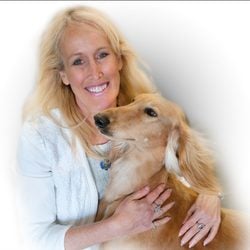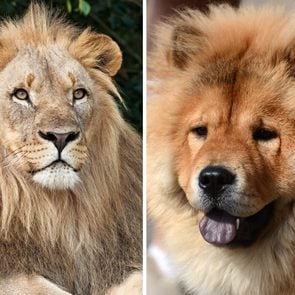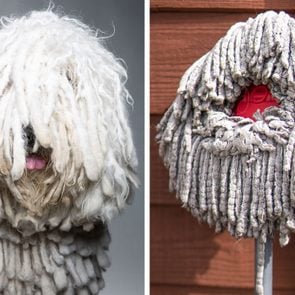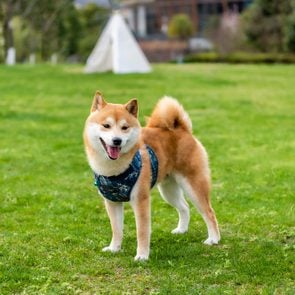15 Dogs That Look Like Bears You’ll Want to Cuddle ASAP
Updated: Apr. 04, 2024
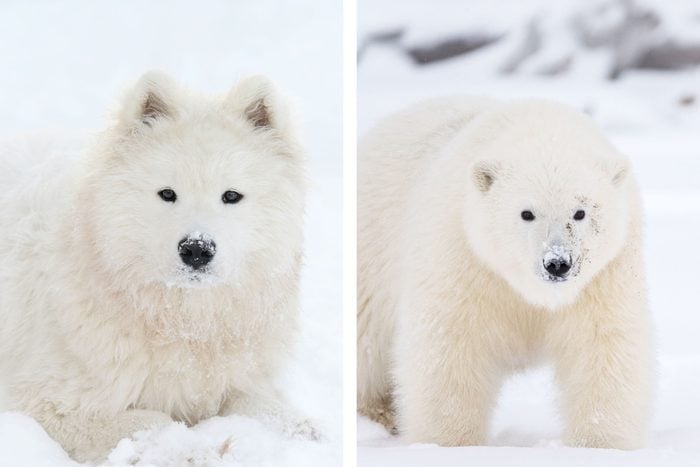
We don't blame you for wanting to give a big bear hug to these adorable dogs that look like bears
When it comes to dogs, there’s fluff, and then there’s fluff. Certain dog breeds have dense coats that seem to go on fur-ever, giving them a certain bear-like appearance. And the similarities to bears don’t end there—some have blacks masks or button eyes (we’re looking at you, Samoyeds), and one breed even runs like a bear. It’s enough to make you wonder if these dogs that look like bears used to hibernate in a past life!
As cute as they are, bear-like dogs aren’t suited for every household. Apart from a few pint-sized exceptions (which we’ve included on our list), these dogs look like bears partly because they’re big—in some cases, really big, weighing in at more than 100 pounds. So despite some of them being among the most popular dog breeds, they might not be suited for apartment living or small yards, and some of them need vigorous daily exercise. Most of them are also major shedders and need regular brushing and grooming to keep their coats clean, healthy and odor-free. And virtually all of them were bred for cold climates, so they don’t do well in hot weather, according to the American Kennel Club (AKC).
But if you think you’re ready for a bear-alicious buddy (or just want to enjoy a few adorable pictures), take a look at these dog breeds that look like bears. Ahead, you’ll find out everything you need to know about them—from what they were bred for to what they’d be like snuggling up in your home!
Get Reader’s Digest’s Read Up newsletter for more pets, cleaning, humor, travel, tech and fun facts all week long.
1. Great Pyrenees
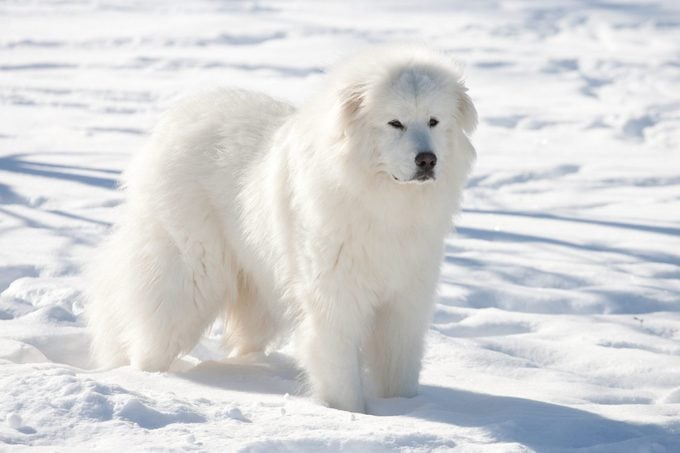
These super furry white dogs are gentle giants—unless one of their flock is threatened. Bred to blend in and protect herds of sheep, the breed developed in the Pyrenees Mountains that divide France from Spain. But experts believe that these fluffballs may have originally migrated with herders from Asia Minor, arriving on the European continent around 3000 BCE. Today, these moderately active dogs are content with a nice walk and a cool place to chill out. Their coats naturally resist dirt and tangles, but they do need brushing a few times a week. They also will need a shedding “blowout” a couple of times a year, so get the vacuum cleaner ready!
Pyrs, as they’re called by their fans, are smart, affectionate, good with kids and highly loyal to and protective of their families. But due of their size—100 pounds and up for males; 85 and up for females—they need ample space to splay on the floor, so they aren’t ideal for apartment living. And because of their thick, double coats, they aren’t suited to hot climates.
2. Chow chow
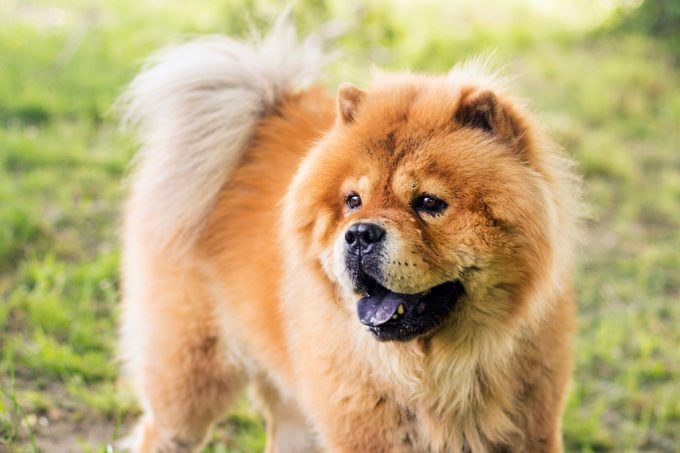
Perhaps the beariest of dogs that look like bears, rough-coated chow chows are sturdy bundles of puff, with short noses, deep-set eyes and manes around their faces. Their double coats do shed a lot, so they need to be brushed a few times a week; the fur around their head and hindquarters is especially prone to matting if they’re not groomed regularly.
Originally bred as hunters and guard dogs in China, chows are thought to be one of the oldest dog breeds. Just be aware that they tend to be a bit aloof and wary, and they’re not always friendly with other dogs. For a well-socialized adult chow, be sure to introduce him as a pup to children and other dogs, and enroll him in obedience training. These furballs require a moderate amount of exercise, with very little running, and can adapt to city and apartment living.
3. Newfoundland
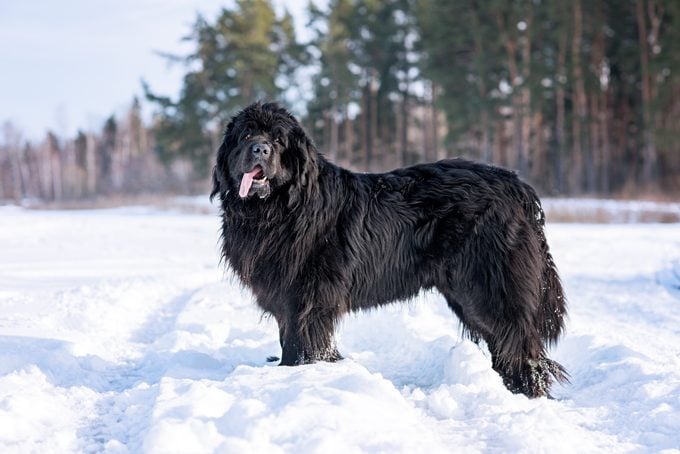
If you spot a bear swimming in a lake or at the beach and see his tongue hanging out, he may not be a bear at all—he may be a Newfoundland! Bred in Canada’s icy Newfoundland and Labrador province as maritime working dogs, Newfies were renowned for their fearlessness and lifesaving abilities. They were used in World War II as search-and-rescue dogs and were renowned for their ability to conduct waterborne rescues.
Today, these great companion dogs are instead famous for their sweet dispositions and love of children. They may wind up outweighing their owners, though! Considered a giant breed (males weigh between 130 and 150 pounds; females, 100 to 120 pounds), Newfies need room to spread out, a lot of human or animal company, moderate exercise and owners who are tolerant of shedding and drool—lots of drool. Oh, and they appreciate a swimming pool too.
4. Caucasian shepherd dog
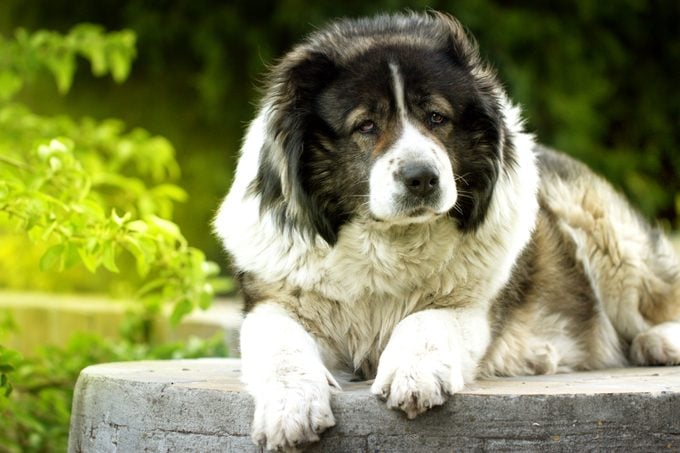
Also called the Caucasian Ovcharka or Russian bear dog, the Caucasian shepherd dog was bred as a fierce and fearless guarder of flocks in the Caucasus Mountains, which divide Europe from Asia. These days, you won’t find this giant breed fending off bears or wolves, but these dogs are still uber-protective of their households—to the point that they can be aggressive with strangers and animals.
Since male Caucasians can tip the scales at 170 pounds (!), early training and socialization are a must. Unlike these dogs that are good for first-time owners, Caucasian shepherd dogs require adept owners who can handle the breed’s impressive size, establish themselves as the leader and temper their protective nature. Also worth noting: Their double coats shed a lot and need to be brushed several times a week. These big boys (and girls) also drool quite a bit, so keep a towel handy and use silicone dog mats under their food and water bowls.
5. Samoyed
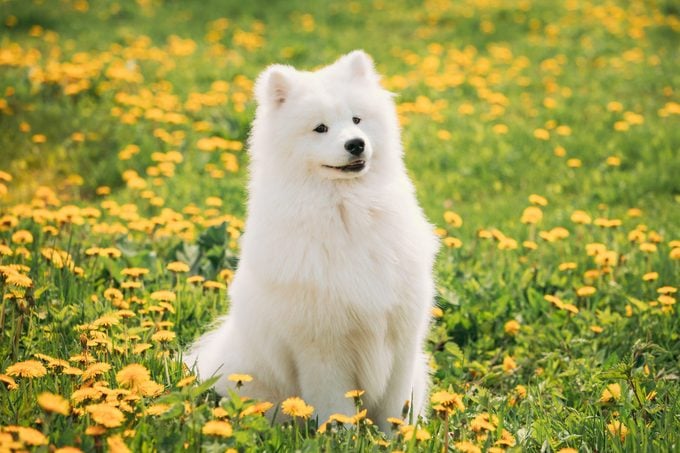
Sweet, fun-loving Samoyeds were bred in Siberia and the northernmost part of Asia to withstand some of the world’s coldest temperatures. Today, these medium-sized “polar bear dogs” do just fine in an air-conditioned home during the summer months. Sammies love their human family members, including children, and do not like being left alone for long periods of time—they’ll get quite barky when bored or lonely. And their trademark white, fluffy coat sheds pretty much all the time, so they need several brushings a week. But one look at that cute, “smiling” expression and you’ll forgive them for the extra work.
All in all, these medium-sized pups (they max out at 65 pounds, and females weigh less) are great family dogs—playful, affectionate and always ready to make new friends. The breed is generally quite healthy, but owners do need to watch out for hip and eye problems.
6. Pomeranian
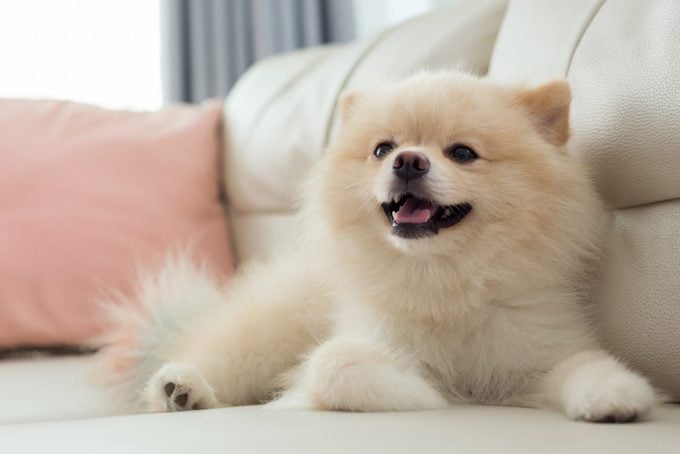
Does any living thing look more like a stuffed animal than a Pomeranian puppy? They’re even on our list of the cutest teddy-bear dogs, and their cuteness definitely doesn’t diminish as they mature. Generally lovable and friendly, Pomeranians love to play with a ball or squeaky toy in the house, but because of their dense double coat, they can’t stand long periods of exercise outdoors in hot weather. (The latter is true for most of the bear-like dogs on this list.)
While they love children, their petite size—they weigh just 3 to 7 pounds—means they may not be ideal for homes with rambunctious kids. Poms will probably do a seasonal shedding twice a year, but because they’re so small, it’s not that much hair. That said, their luxuriously fluffy, double coat needs to be brushed a few times a week or else it can get matted.
7. Keeshond
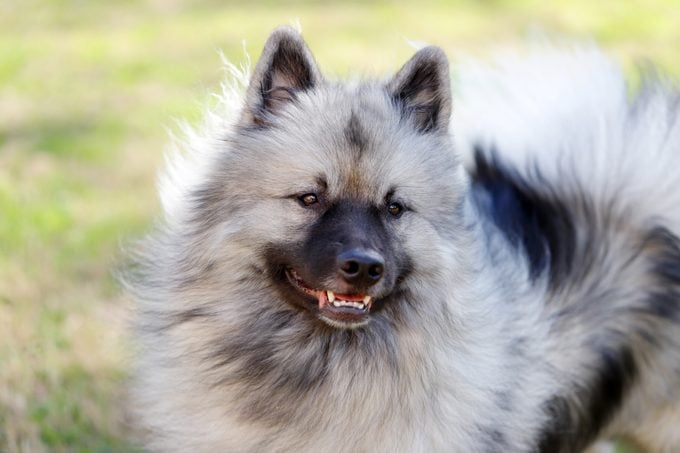
If you’re looking for a medium-sized bear-like dog breed that’s a loving companion and loyal family dog, the Keeshond checks all the boxes. These bundles of gray-, black- and cream-colored fur were bred as companion dogs for Dutch bargemen, and they take that role seriously to this day—they are delighted to spend time with their people and don’t like to be left alone for long periods of time. The AKC gives top marks to Keeshonden as terrific family dogs, since they’re great with kids and other dogs and they’re generally always up for a good time. They’ll adapt to apartment living, little kids and other pets, and as long as you promise to adore them and shower them with cuddles, you’ll have a loving friend for life. But these friendly pups are no couch potatoes: They have nonstop energy and need a lot of daily interaction. They do well with at least one or two brisk walks a day, room to romp and a collection of stimulating toys.
8. Eurasier
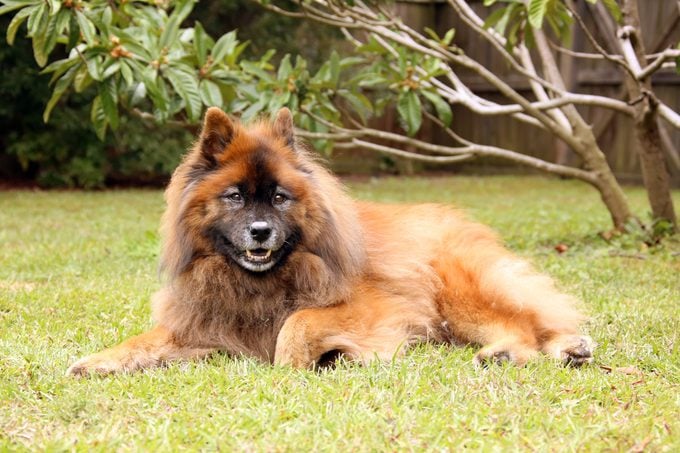
Similar in size to the Keeshond, the Eurasier also shares some of that breed’s qualities, including a bear-like appearance and a desire to be around their human family, though they may be somewhat reserved with strangers. Considered a purebred breed, Eurasiers weren’t developed until the 1960s and ’70s, when a dog enthusiast in Germany crossbred a chow chow and a wolf spitz. Today, Eurasiers are popular in Europe’s colder climates but are still among the rarest dog breeds in the United States.
These friendly fluffballs have double coats like their ancestors and will “blow” (or completely shed) their undercoats a few times a year, so expect frequent brushing, sweeping and vacuuming! While Eurasiers are generally healthy pups, owners do have to watch for hip and elbow displasia, as well as slipped kneecaps.
9. Tibetan mastiff
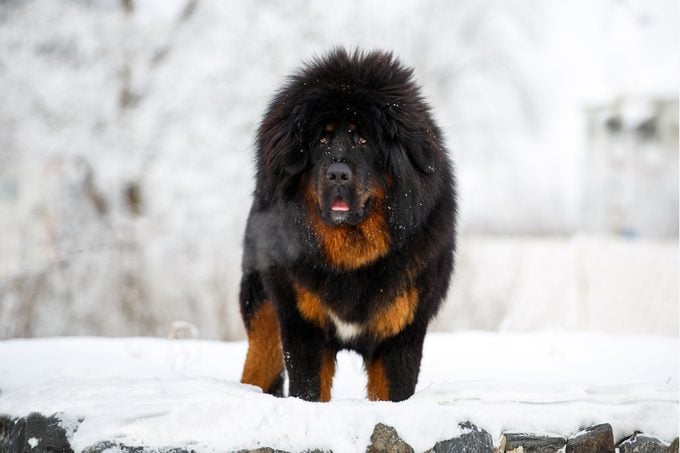
Do you want girth? Do you want fluff? Do you want a big dog that looks like a bear? We recommend the Tibetan mastiff, a bear-like dog originally bred as a watchdog in the high Himalayas that’s now just as happy to serve as a playful, protective family companion. Tall and stocky, Tibetan Mastiffs have a dense double coat that makes them look even heftier—though they do tip the scales at up to 150 pounds.
Just be aware that they are heavy shedders and need brushing a few times a week to keep their fur clean, so it’s a commitment. You’ll also want to check those furry paws at the door to prevent them from tracking in dirt. This is a breed made for cold climates, so it’s best to keep this puffy pal indoors during the hottest times of the day so as not to run the risk of overheating or heat stroke.
10. Finnish Lapphund
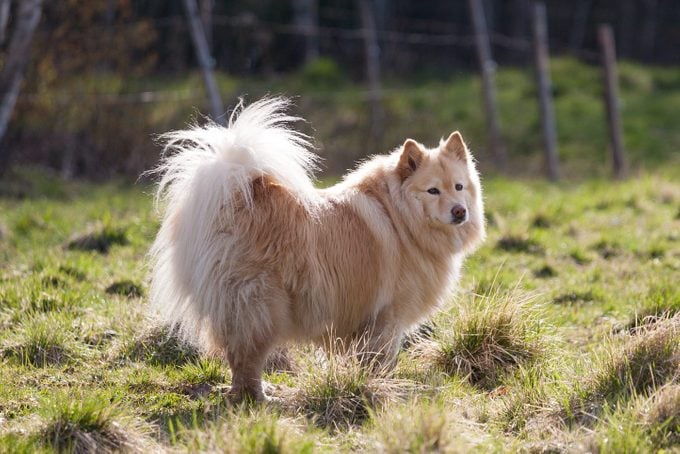
Bred to herd reindeer in Finland as far back as 7000 BCE, these medium-sized fluffsters (they average around 45 pounds) have taken to domestic life and are highly friendly, affectionate, adaptable family dogs. Their double coats shed nearly constantly, so be prepared for a lot of grooming and vacuuming. Another thing to know about Lappies: They bark—a lot—which was instrumental when they needed to get those reindeer moving. This makes them less suited to apartments or condos. Since they were bred for Arctic climates, they also do better in a cold-weather environments. The more snow for them to trounce through, the better!
11. Bernese mountain dog
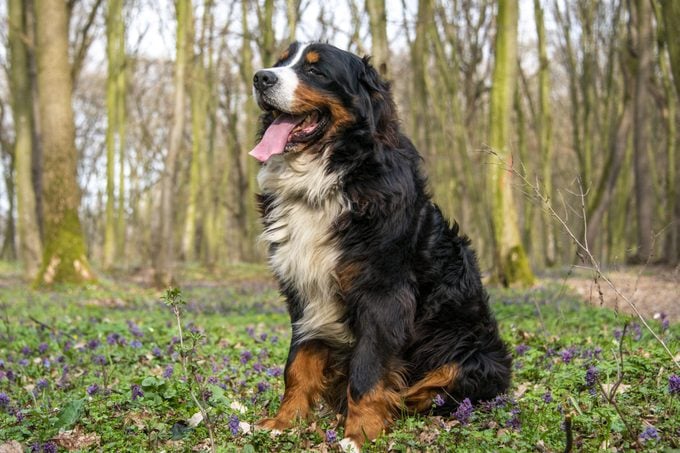
These gentle giants are known for their superlatives: They’re incredibly friendly and loving with their families, they absolutely love to play, they’re amazing with children and other dogs … and they shed like crazy. Historically, that heavy double coat protected Berners from Switzerland’s Alpine winters, and now, their longish black coat with white and red accents makes them stand out as dignified yet lovable hunks.
Because of their high energy levels, Berners do best when they have daily exercise or room to run around, after which they’ll be content to lounge or snuggle with their families. As goofy and friendly as these pups are, they can also be a handful due to their size and exuberance—it’s important to obedience-train them early so they don’t jump up on or accidentally clobber anyone when greeting them.
12. Bouvier des Flandres
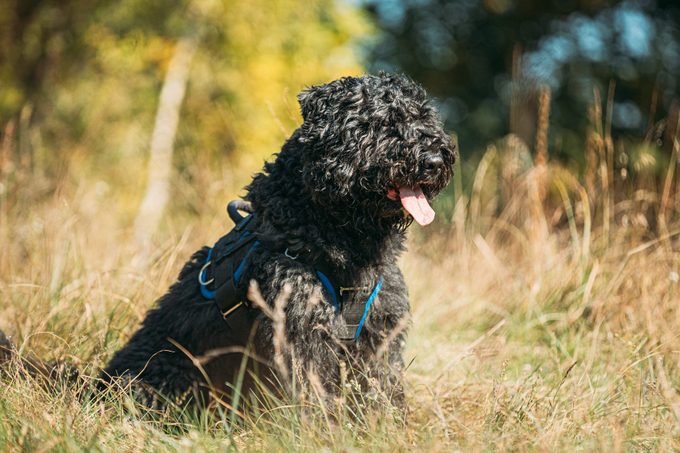
If black bears had pointy ears, you might mistake them for Bouviers, the furballs of the Flanders region of Northern Europe. Bred for farm chores that might have included herding, pulling carts and even turning butter churns, this breed is still known for its loyalty and intelligence. Like other herding and working breeds, Bouviers need a job that provides mental and physical stimulation. They’re great at herding and carting, and respond well to routine and consistency. For that reason, these fluffy pups need a human companion who can give them lots of time and attention—as well as nearly daily brushing for that thick, rough double coat. The AKC notes that Bouviers are strongly prey-driven, so they might need some training that includes impulse control.
13. Old English sheepdog
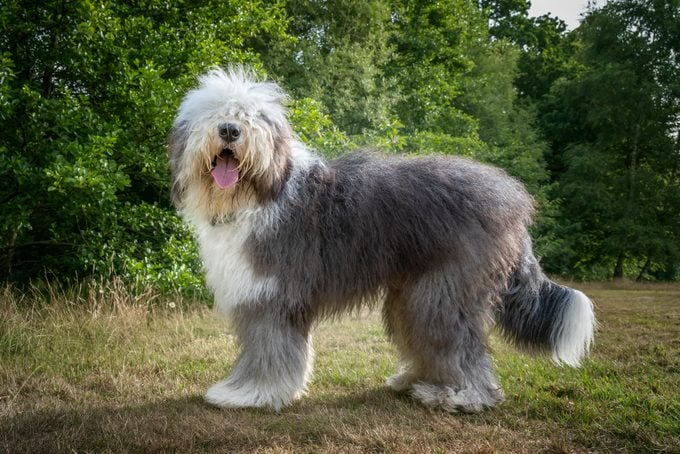
Sure, you probably won’t mistake that giant bundle of fur bounding toward you for a bear, but that’s only because it’s the wrong color! These giant pups with fluffy gray and white coats are known for their distinctive rolling gait, which resembles that of a bear on the run, as well as for being incredibly affectionate and loyal, especially with small children. The shepherding days of the Old English sheepdog (OES) may be behind them, but they’ll still watch over and defend their flock, making these sturdy pups the perfect combination of watchdog and playful family pet.
That gorgeous coat comes with a lot of work, though. OESes require nearly daily brushing or their long hair will quickly get matted. They can also make a mess when outside (think mud puddles!), so you’ll want to train them early to stay off furniture—at least until you’ve had a chance to clean them up.
14. Leonberger
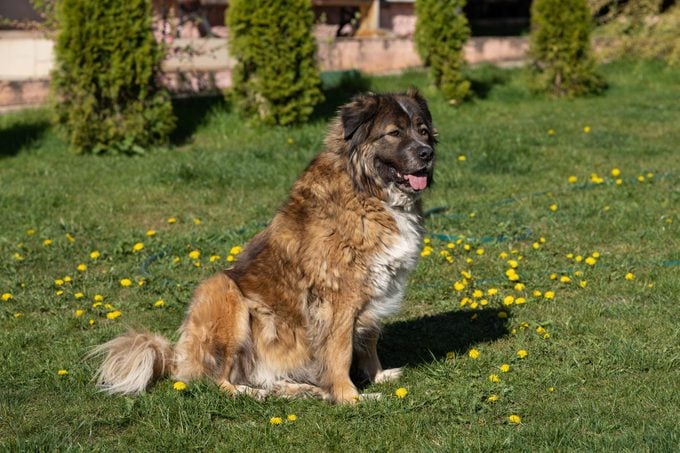
This relatively rare German dog breed was developed in the 19th century (ironically, to look like lions!) but almost didn’t survive the 20th—Leonbergers were nearly wiped out twice in the two world wars. Today, the AKC-recognized breed is known for its affectionate ways, openness to strangers and compatibility with children … a far cry from when these brave dogs were put to work pulling ammunition carts in World War II. Leos are still eager to please, and they do best when trained as young puppies and given mentally and physically stimulating tasks, such as daily hikes and retrieval games.
Their long double coats, which range from sand-colored to rusty brown, require near-daily grooming with a metal comb and slicker brush. Also keep in mind that Leos run large—males can reach up to 170 pounds, and females can weigh 140.
15. Estrela mountain dog
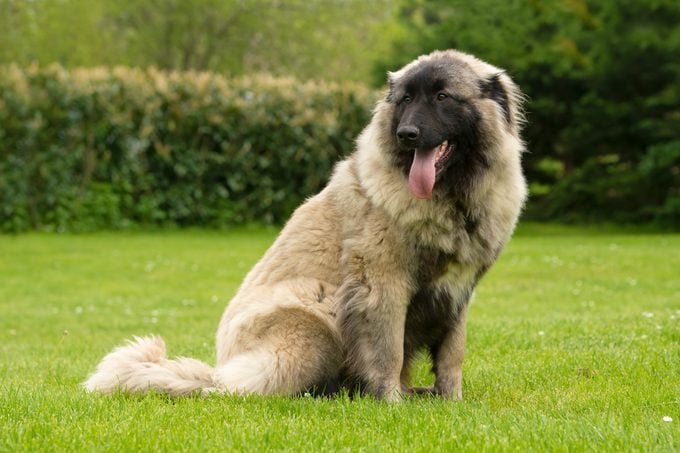
With its dark mask and serious expression, the Estrela mountain dog really does resemble a bear. This Portuguese breed was developed for guarding livestock, and that need to protect is still one of its key traits: Estrelas are generally friendly family dogs—unless someone or something threatens their pack. The Portuguese military has actually used these dogs in firefighting, as well as in army and navy jobs, according to their breed club. Because of the Estrela’s strong-willed, protective nature, experts say this breed is best suited to owners who can be present, patient and consistent, making sure to socialize their Estrela puppy, including with small animals, while it’s still young.
And that long, wavy double coat? It does need regular brushing and combing, and it sheds a lot twice a year—but it’s worth it for its snuggle value. Another interesting trait: All Estrelas have double dewclaws.
Why trust us
At Reader’s Digest, we’re committed to producing high-quality content by writers with expertise and experience in their field in consultation with relevant, qualified experts. For this piece, Elizabeth Heath tapped her experience researching and writing about dog breeds and behavior, and then Caroline Coile, PhD, an award-winning journalist specializing in canine breeds, health and science, gave it a rigorous review to ensure that all information is accurate and offers the best possible advice to readers. We verify all facts and data, back them with credible sourcing and revisit them over time to ensure they remain accurate and up to date. Read more about our team, our contributors and our editorial policies.
Sources:
- American Kennel Club: “Dog Breeds”
- Bouvier des Flandres Club of Great Britain: “History of the Breed”
- Great Pyrenees Club of America: “Breed Info/History”
- Newfoundland Club of America: “Search and Rescue Dogs in World War II”
- Pomeranian.org: “Summer Pomeranian Care”
- United States Eurasier Club: “Eurasier Health”
